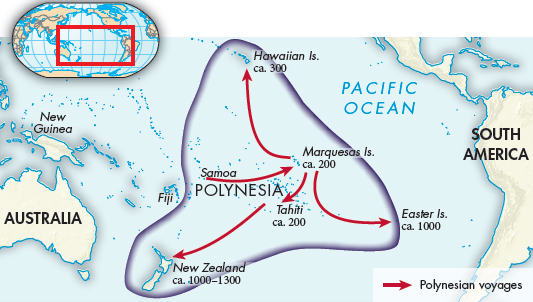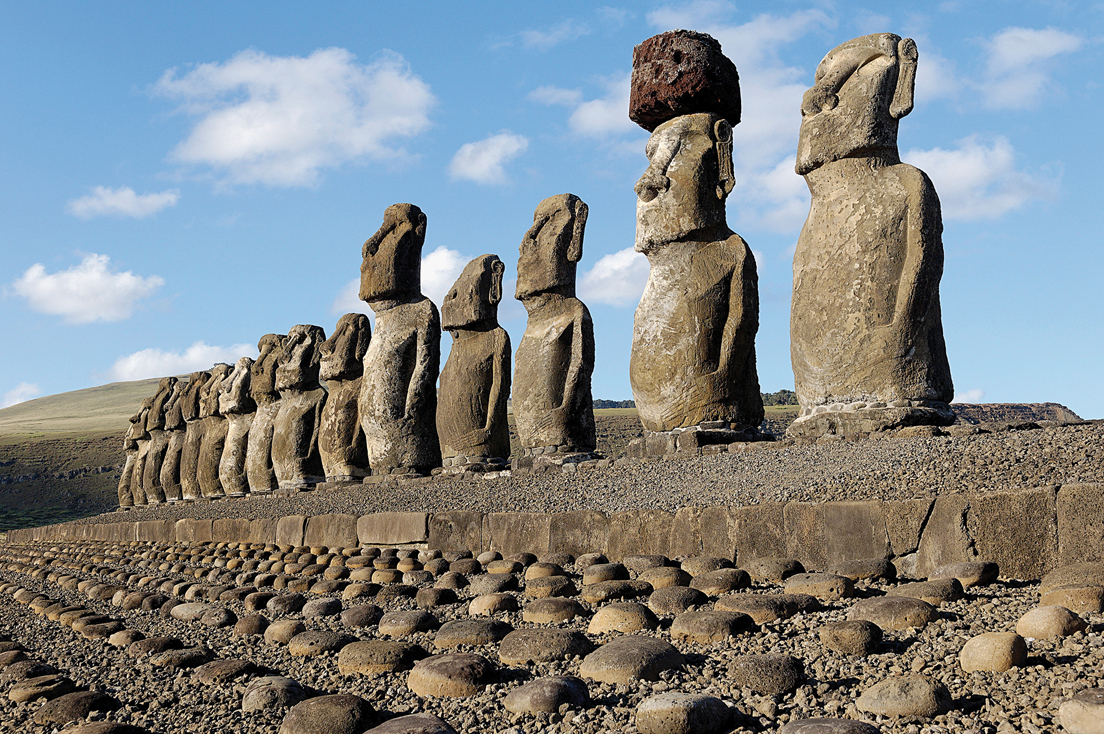A History of World Societies:
Printed Page 357
A History of World Societies Value
Edition: Printed Page 355
The Settlement of the Pacific Islands

Through most of Eurasia, societies became progressively less isolated over time. But in 1400 there still remained many isolated societies, especially in the Islands east of modern Indonesia. As discussed in Chapter 1, Homo sapiens began settling the western Pacific Islands very early, reaching Australia by 50,000 years ago and New Guinea by 35,000 years ago. The process did not stop there, however. The ancient Austronesians (speakers of Austronesian languages) were skilled mariners who used double-
After reaching the central Pacific, Polynesians continued to fan out, in some cases traveling a thousand or more miles away. They reached the Hawaiian Islands in about 300 C.E., Easter Island in perhaps 1000, and New Zealand not until about 1000–
In the more remote islands, such as Hawai‘i, Easter Island, and New Zealand, the societies that developed were limited by the small range of domesticated plants and animals that the settlers brought with them and those that were indigenous to the place. Easter Island is perhaps the most extreme case. Only 15 miles wide at its widest point (only 63 square miles in total area), it is 1,300 miles from the nearest inhabited island (Pitcairn) and 2,240 miles from the coast of South America. At some point there was communication with South America, as sweet potatoes originally from there made their way to Easter Island. The community that developed on the island raised chickens and cultivated sweet potatoes, taro, and sugarcane. The inhabitants also engaged in deep-

What led the residents of such a small island to erect more than eight hundred statues, most weighing around ten tons and standing twenty to seventy feet tall? When the first Europeans arrived in 1722, no statues had been erected for several generations, and the local residents explained them as representing ancestors. One common theory is that they were central to the islanders’ religion and that rival clans competed with each other to erect the most impressive statues. The effort they had to expend to carve them with stone tools, move them to the chosen site, and erect them would have been formidable.
After its heyday, Easter Island suffered severe environmental stress with the decline of its forests. Whether the rats that came with the original settlers ate too many of the trees’ seeds or the islanders cut down too many of the trees to transport the stone statues, the impact of deforestation was severe. The islanders could not make boats to fish in the ocean, and bird colonies shrank as nesting areas decreased, also reducing the food supply. Scholars still disagree on how much weight to give the many different elements that contributed to the decline in the prosperity of Easter Island from the age when the statues were erected.
Certainly, early settlers of an island could have a drastic impact on its ecology. When Polynesians first reached New Zealand, they found large birds up to ten feet tall. They hunted them so eagerly that within a century the birds had all but disappeared. Hunting seals and sea lions also led to their rapid depletion. But the islands of New Zealand were much larger than Easter Island, and in time the Maori (the indigenous people of New Zealand) found more sustainable ways to feed themselves, depending more and more on agriculture.